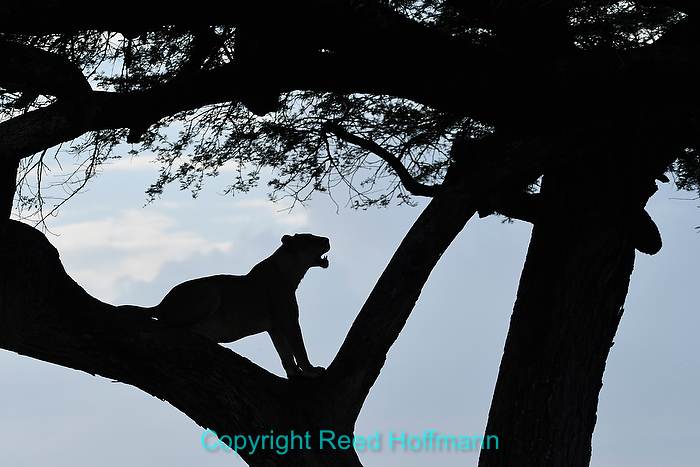In late June I led my seventh trip to the Serengeti in east Africa to photograph wildlife. People ask me, “Don’t you get bored returning to the same place again and again?” And of course, my answer is “No.” While we go to the same areas, the animals, and their behavior, are always different. Every trip has its special moments, and below are some from this one. Want to join me on the next trip? If so, send me an email and I’ll let you know when I’m going.
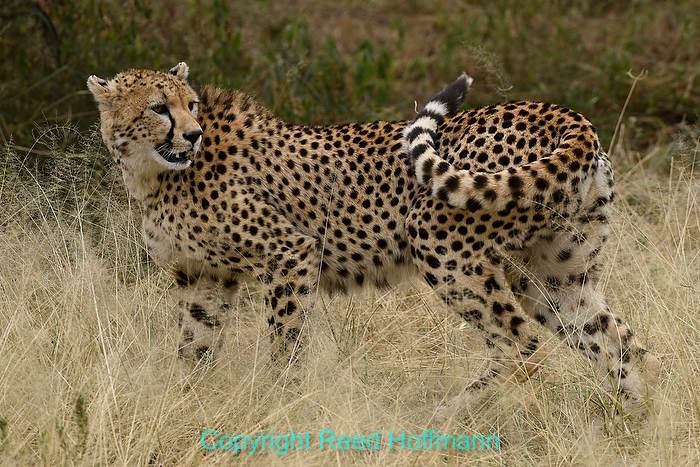
On our first day out, we usually visit Lake Manyara National Park. It’s on the way to the Serengeti, and a great place to get warmed up. But this time I wanted to try something new and visit Tarangire National Park instead. I’d heard that it had great resident elephant herds, and also that due to recent heavy rains parts of Manyara were flooded. What I didn’t expect to find were Cheetahs. Every trip I’ve led to Africa we’ve seen Cheetahs, but rarely up close, and certainly never this close to the city of Arusha. Not thirty minutes into the park, we found a pair of cheetahs (mother and nearly grown cub). Better yet, they were relatively close to the road, meaning good photos. After we watched them for a bit, they got up and moved off, and that’s when I made this photo of the cub. I’ll definitely return to Tarangire in the future! Photo copyright Reed Hoffmann. Nikon D500, Aperture Priority, ISO 560, 1/1600 at f/5.6, 0.0 EV, Nikkor VR Zoom 200-500mm f/5.6 lens at 200mm.
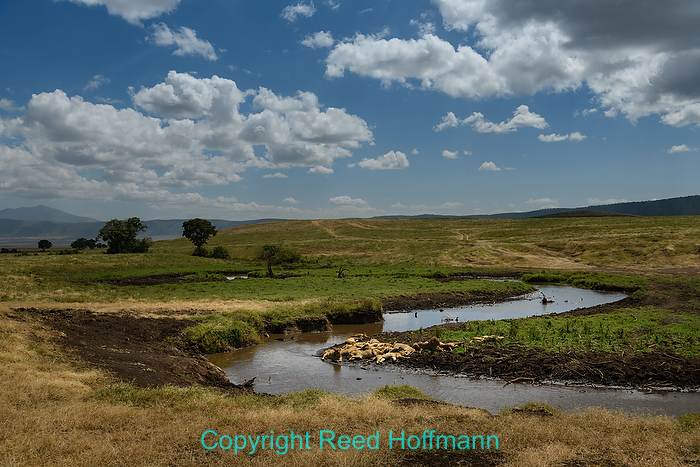
The second day of the trip we spent in Ngorongoro Crater, whose volcanic eruption eons ago created the Serengeti. It’s also essentially an ecosystem in itself, as the wildlife inside (except for birds and the occasional elephant) stay in the crater (actually a caldera). We came upon a group of lions just after they’d taken down a wildebeest, but too far away for good photos. But then one lioness left the group and started walking away. Our guide thought she might be going to get her cubs, so we followed. We never found any cubs, but did find twenty-two (22!!!) lions napping by a creek. I really liked the landscape photo that made, where it takes you a minute to realize all that brown on the bank is a bunch of lions. Photo copyright Reed Hoffmann. Nikon D850, Aperture Priority, ISO 64, 1/400 at f/8, 0.0 EV, Nikkor VR Zoom 24-120mm f/4G IF-ED lens at 32mm.
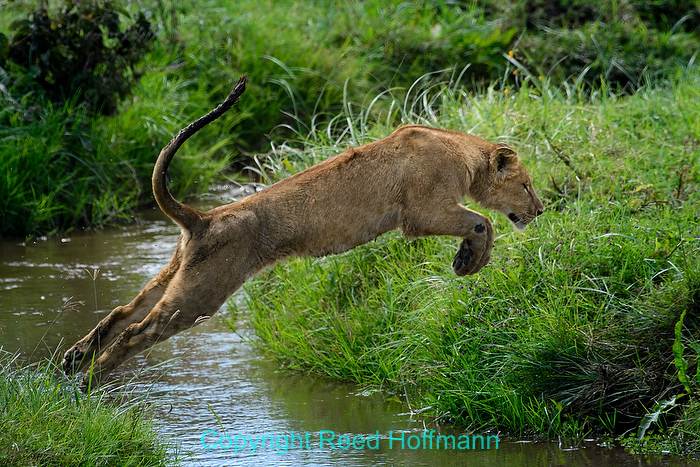
As the lioness drew near, the others perked up and some started jumping across the creek to meet her. Catching them in mid-air was fun. Photo copyright Reed Hoffmann. Nikon d500, Aperture Priority, ISO 720, 1/1600 at f/5.6, 0.0 EV, Nikkor VR Zoom 200-500mm f/5.6 lens at 390mm.
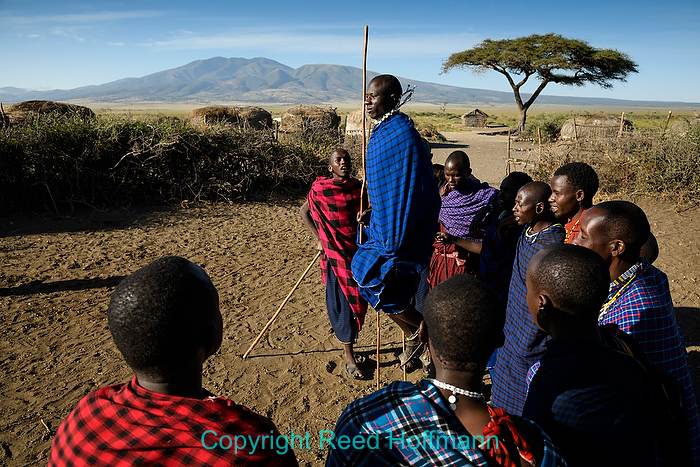
On the third day we departed Ngorongoro to enter the Serengeti, and on the way stopped at a Maasai village. It’s always a fascinating visit, as these people maintain the same nomadic lifestyle they have for hundreds of years. Their culture and diet revolve around herds of cows, sheep and goats, and they live in a hot, dry and inhospitable area. They always welcome visitors on arrival with songs, and the men do a jumping dance called the “adumu.” Holding my camera high overhead, I used the LCD to frame the jumper surrounded by the others. Photo copyright Reed Hoffmann. Nikon D850, Aperture Priority, ISO 200, 1/500 at f/6.3, -0.3 EV, Nikkor VR Zoom 24-120mm f/4G IF-ED lens at 27mm.
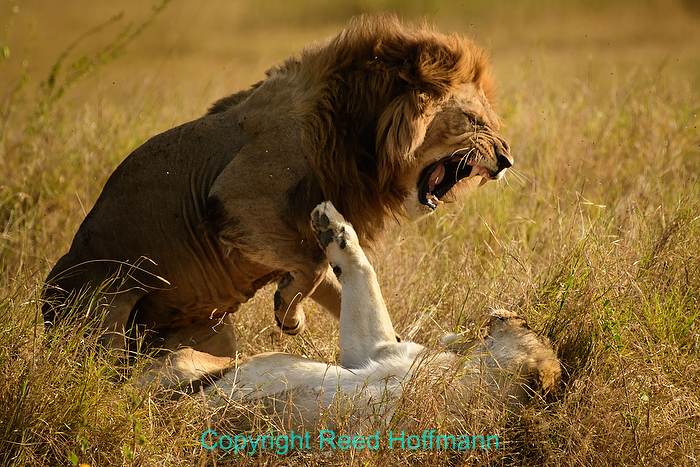
Occasionally on these trips we’ve witnessed lions mating, which the guides always refer to as “they’re on honeymoon.” In this case we’d stopped to photograph some hippos when our guide thought he saw a lion’s tail above the grasses. He drove the truck over for a better view, and sure enough, there were a pair of lions “on honeymoon.” Since they were in a great location for pictures (not far away, sidelit, great background), we settled in to wait. The pair will mate up to eighteen times a day during daylight hours, so if you have the time, it’s worth the wait. Sure enough, after about a half hour the action commenced. A minute later it was over, and as the male dismounted, the female rolled over and took a swipe at him. True love. Photo copyright Reed Hoffmann. Nikon D500, Aperture Priority, ISO 560, 1/1600 at f/5.6, -0.3 EV, Nikkor VR Zoom 200-500mm f/5.6 lens at 500mm.
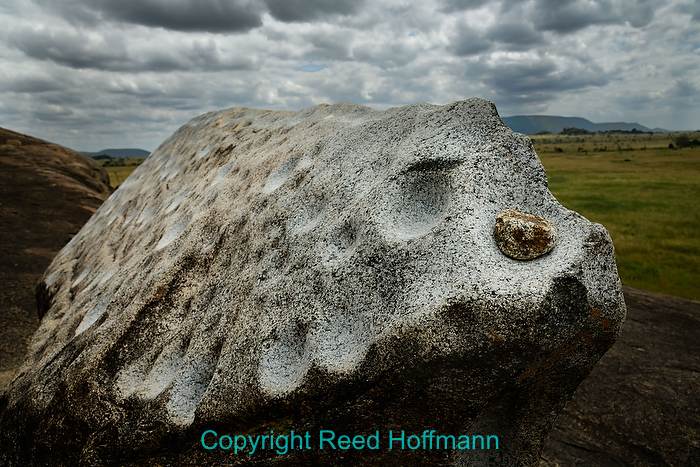
There are two primary rules in the Serengeti. One, that trucks must stay on the roads, except in certain areas. And two, that you’re not allowed to get out of the trucks. That second rule has its exceptions, as there are a few places where you can get out to stretch your legs, use a toilet or even sit and eat your box lunch. One spot we visited is called Moru Kopjes, a series of rock outcrops that’s home to a rather special boulder, called the “Gong Rock.” In centuries past the Maasai carved indentations in it, and when struck with a smaller rock it creates loud ringing sounds that were used to send messages across the savannah. Photo copyright Reed Hoffmann. Nikon D850, Aperture Priority, ISO 100, 1/400 at f/8, -0.3 EV, Nikkor VR Zoom 24-120mm f/4G IF-ED lens at 24mm.
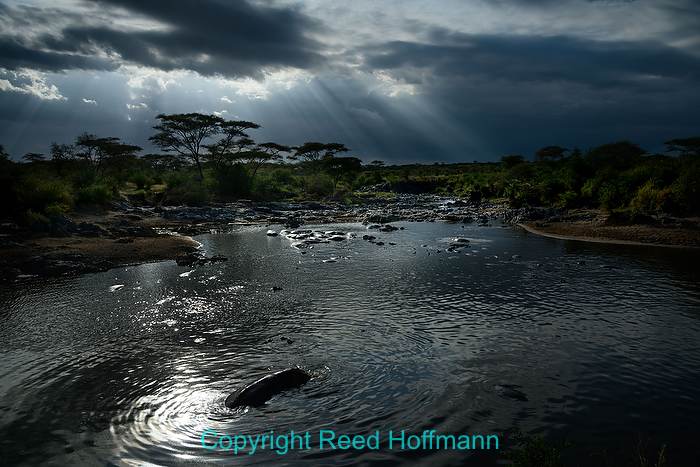
One of my favorite places in the Serengeti is called the Hippo Pool, because, well, it’s always full of hippos. Most of the photos we make there are of them yawning and occasionally fighting. But this time, visiting late in the day, the combination of backlight and a dramatic sky called for a wide-angle shot instead. Photo copyright Reed Hoffmann. Nikon D850, Aperture Priority, ISO 64, 1/640 at f/7.1, -0.7 EV, Nikkor VR Zoom 24-120mm f/4G IF-ED lens at 27mm.
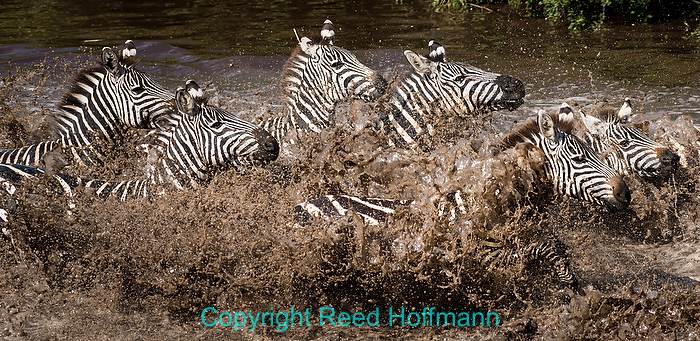
In the Serengeti, water means life, but it can also mean death. The animals have to drink and the predators know that. Which means if you find zebra or wildebeest at a watering hole, they’re going to be very nervous. You have to wait patiently as they cautiously approach the water, look for crocodiles, and then start drinking. The best pictures, though, come when one of them gets spooked and the whole herd comes stampeding out. Photo copyright Reed Hoffmann. Nikon D500, Aperture Priority, ISO 450, 1/1600 at f/5.6, 0.0 EV, Nikkor VR Zoom 200-500mm f/5.6 lens at 360mm.
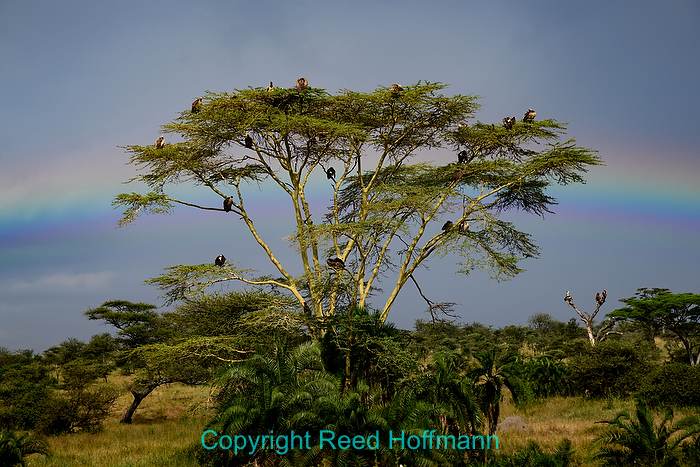
Visiting in late June, we’re there at the beginning of the dry season but still get an occasional shower. That’s okay, though, because it usually gives us some dramatic skies to work with. This time we even had a rainbow, but as always, the challenge was finding something to have in the foreground before it was gone. I’m guessing this will be the only time I have a tree full of vultures in a rainbow picture. Photo copyright Reed Hoffmann. Nikon D850, Aperture Priority, ISO 200, 1/1000 at f/6.3, 0.0 EV, Nikkor VR Zoom 24-120mm f/4G IF-ED lens at 120mm.
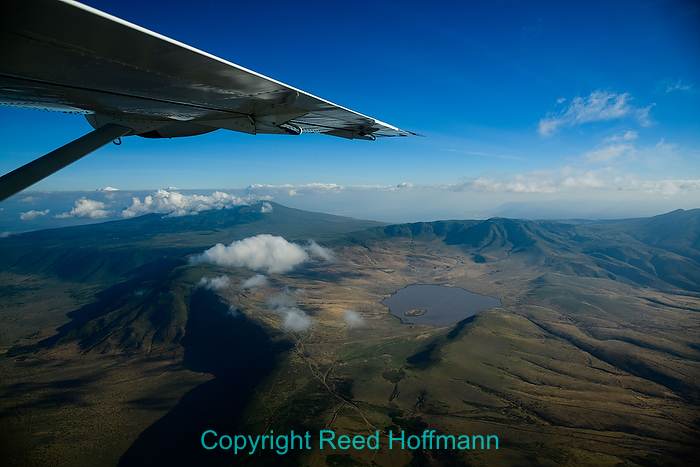
I’ve always got mixed feelings when leaving the Serengeti. While I’m happy to be headed back home after a long trip, I’m also a bit sad to be leaving such a beautiful and wildlife-rich country. On the way in, we spend two days driving, with stops at other parks, to reach the Serengeti. On our way out, though, we fly, not just to save time, but to also have one last grand view of this exceptional place. This photo is as we pass by Ngorongoro Crater, where we spent our second day. Photo copyright Reed Hoffmann. Nikon D850, Aperture Priority, ISO 200, 1/1000 at f/6.3, 0.0 EV, Nikkor VR Zoom 24-120mm f/4G IF-ED lens at 24mm.
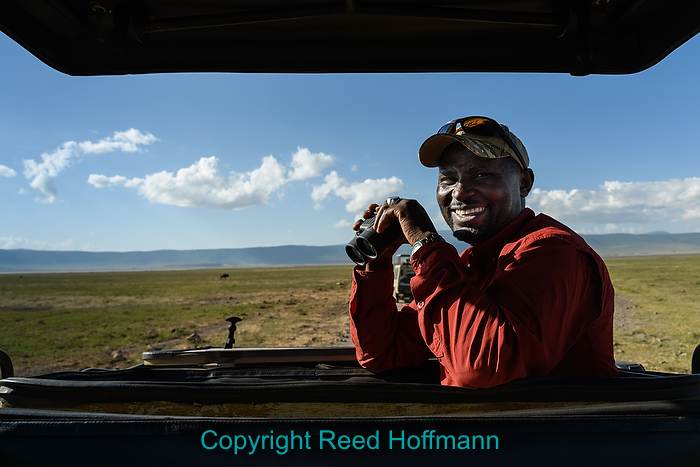
None of the trips I’ve led would have been nearly as good without an excellent guide. I’ve worked with Yusuf Ngaina since the first trip, and he’s unfailingly upbeat, fun, and most importantly, full of fascinating information about both the Serengeti and the wildlife there. We’re lucky to have him, and I look forward to working with him on future trips. Photo copyright Reed Hoffmann. Nikon D850, Aperture Priority, ISO 200, 1/1000 at f/7.1, -0.3 EV, Nikkor VR Zoom 24-120mm f/4G IF-ED lens at 24mm.
(If you like this story, please share it with your friends and let them know about the links on photography I post on my business Facebook page. I’m also on Instagram and Twitter, @reedhoffmann)

